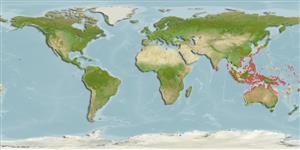Common names from other countries
Classificação / Names
Nomes comuns | Sinônimos | Catalog of Fishes(Gênero, Espécies) | ITIS | CoL | WoRMS | Cloffa
>
Gobiiformes (Gobies) >
Gobiidae (Gobies) > Gobionellinae
Etymology: Gnatholepis: Greek, gnathos = jaw + Greek,lepis = scale (Ref. 45335).
More on author: Bleeker.
Environment: milieu / climate zone / depth range / distribution range
Ecologia
marinhas associadas(os) a recifes; intervalo de profundidade 0 - 12 m (Ref. 92171). Subtropical
Western Pacific: relatively restricted from the Cocos-Keeling Islands, Philippines, Taiwan, southern Japan, Indonesia, New Guinea, Solomon Islands and Vanuatu.
Tamanho / Peso / Idade
Maturity: Lm ? range ? - ? cm
Max length : 5.5 cm SL macho/indeterminado; (Ref. 92171)
This moderate-sized (up to 55 mm SL) species has a distinctive colour pattern: in males, with 6 broad vertical dark blotchy bars along mid-side of body, several staggered rows of black spots along the dorsal part of the body, 1-4 irregular rows of golden yellow (in life) spots along lower half of body, 2 characteristic small black spots at base of first dorsal fin, and 1-3 staggered rows of oval black ocellate spots on anal fin (in life, red, blue and yellow may surround black spots); in females, with vertical dark body bars much paler and red and yellow markings much less distinct; D2 and anal fin rays nearly always I,11; pectoral rays 15-17 (usually 16); lateral scales 24-30 (usually 26); predorsal scales 9-10 (usually 8-9), ctenoid and cycloid (Ref. 92171).
Found in shallow waters, from reef tidepools, among seagrass, in shallow mangroves and (usually) sand and coral rubble reef substrates at depths of 0.2-12 m (Ref. 92171).
Ciclo de vida ou comportamento de acasalamento
Maturities | Reprodução | Spawnings | Egg(s) | Fecundities | Larvas
Larson, H.K. and D.J. Buckle, 2012. A revision of the goby genus Gnatholepis Bleeker (Teleostei, Gobiidae, Gobionellinae), with description of a new species. Zootaxa 3529:1-69. (Ref. 92171)
Status na Lista Vermelha da UICN (Ref. 130435)
CITES (Ref. 128078)
Not Evaluated
Ameaça para os humanos
Harmless
Uso pelos humanos
Ferramentas
Relatórios especiais
Baixar XML
Fontes da internet
Estimates based on models
Preferred temperature (Ref.
115969): 26.5 - 29.3, mean 28.7 (based on 1531 cells).
Índice de diversidade filogenética (Ref.
82804): PD
50 = 0.5010 [Uniqueness, from 0.5 = low to 2.0 = high].
Bayesian length-weight: a=0.00977 (0.00442 - 0.02163), b=3.05 (2.86 - 3.24), in cm Total Length, based on LWR estimates for this (Sub)family-body shape (Ref.
93245).
Nível Trófico (Ref.
69278): 3.3 ±0.4 se; based on size and trophs of closest relatives
Resiliência (Ref.
120179): Elevada, tempo mínimo de duplicação da população menor que 15 meses (Preliminary K or Fecundity.).
Fishing Vulnerability (Ref.
59153): Low vulnerability (10 of 100).
